The result is a disjointed customer experience, and it taught me a critical lesson early in my career: a great product isn’t enough. You need a unified plan that ensures every single customer interaction feels consistent, positive, and valuable.
That plan is your customer experience strategy. It’s the connective tissue that holds your business together. Over the years, from managing support for SaaS platforms like Greenhouse to overseeing e-commerce operations at Skybound, I’ve refined a practical playbook for building a customer experience strategy that doesn’t just sound good in a meeting but actually works in the real world.
Now, I want to walk you through it.
Table of Contents
- What is a customer experience strategy?
- Why is customer experience strategy important?
- Elements of a Customer Experience Strategy
- How to Create a Customer Experience Strategy
- Customer Experience Strategy Best Practices
- How to Measure Your Customer Experience Strategy
- Quick Tips for Optimizing Your Customer Experience Strategy
So, what exactly is a customer experience strategy?
Let’s cut through the jargon. I think of a customer experience strategy as your company’s game plan for every interaction a customer has with your brand. It’s a deliberate, actionable plan to make sure those interactions are positive, consistent, and meaningful. For me, it’s the operational blueprint for how we deliver on our brand promise at every turn.
A successful customer experience strategy should take into account several important factors, such as:
- Competitive insight
- Consumer research
- Marketplace data
- Mission and vision
When defining your customer experience strategy, it’s crucial to include all departments, not just those in customer-facing roles. By incorporating feedback and insight across the company, you'll find it easier to align the organization around the intended goal of improving the customer experience and relationship.
Pro tip: Check out HubSpot’s collection of customer experience tools.
Why is customer experience strategy important?
A strong customer experience strategy is the engine of sustainable growth. Customer experience impacts a company’s brand, operations, and financials. Here are the three key benefits I’ve found a well-implemented CX strategy brings to the table.
1. Higher Loyalty, Lower Churn
Let’s be honest, keeping customers is cheaper than finding new ones. A great experience is your best retention tool. The stakes are high. Research from Zendesk reveals that 73% of consumers will switch to a competitor after multiple bad experiences, and more than half will leave after just one.
On the flip side, a commitment to CX pays off. McKinsey recounts the tale of one of its clients in the telecommunications industry: When it overhauled its customer experience, it cut churn rates by up to 75%. I saw a similar impact when I launched the first NPS program at Trendy Butler. By listening to feedback and acting on it, we created a stickier subscription experience that kept customers coming back.
2. Higher Revenue
The math is simple. Happier, more loyal customers stay longer and spend more. If you operate in an industry with a high customer lifetime value (CLV), one mistake could cost you hundreds or even thousands of dollars.
It’s not just about preventing loss, it’s about actively growing revenue. The latest research underscores this. A 2024 ACA (Achieving Customer Amazement) study found that 70% of customers are willing to pay more if the experience is more convenient, making it a crucial factor that can make price relevant.
It’s worth noting that this is not an overnight solution. Building a reputation for consistent excellence takes time and dedication. But the evidence is clear. For instance, when I worked on improving the CX for that subscription service I mentioned earlier, we not only reduced churn but also saw a clear uptick in new members upgrading their plans. A great experience builds the trust that leads to more valuable and profitable customer relationships.
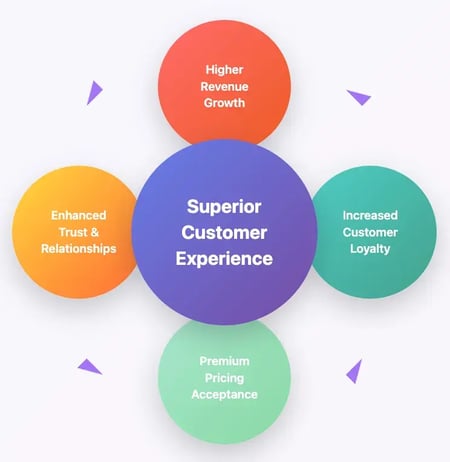
3. Brand Advocacy
Finally, customers who have a good experience are more likely to share on social media or by word-of-mouth about your brand. CX professionals often measure this through the Net Promoter Score (NPS), which asks customers how likely they are to recommend a product or service.
Word-of-mouth remains one of the most trusted forms of marketing, with 74% of consumers saying they trust recommendations from people they know. Those who had a good experience become promoters and contribute to a positive brand reputation and growth. In my current role, I implemented an NPS program that recently achieved a score of 88. That score doesn’t just represent satisfaction but the army of fans ready to advocate for our brand.
Featured Resource: Customer Experience Mapping Template
Elements of a Customer Experience Strategy
To build a strategy that lasts, you need to focus on a few core elements. Think of these as the foundational pillars of your plan.
1. Review your current customer service metrics.
You can’t know where you’re going until you know where you are. I always start by digging into the help desk data. This means establishing a baseline by looking at key metrics like NPS, CSAT, churn rate, and ticket volume. At SmartRecruiters, one of my first projects was creating the team’s operational support framework from the ground up, which started with defining our core KPIs. This gave us a clear, objective view of our performance and highlighted exactly where we needed to improve.
Pro tip: Once you have your data, prioritize improvement efforts based on their potential impact on both customer satisfaction and business goals. Focus on addressing the issues that affect the most customers or lead to the high churn first, rather than trying to fix everything at once.
2. Create a customer journey map.
A customer journey map is essential. It’s a visual representation of every interaction a customer has with you. I’ve found this is the single best tool for identifying points of friction and getting buy-in from other departments. It’s a tool that helps you build empathy across the company while creating a seamless customer journey.
“A customer journey map is a tool in your toolkit as a CX leader to gain that customer understanding,” explains Jeannie Walters, CEO of Experience Investigator.
“But within your organization, it‘s also a way to invite various leaders to participate, to get them to really understand what’s happening. Journey mapping is a verb, not a noun. This is an action you take to get the insights to move forward."
Pro tip: A customer journey map is not a one-time project; it’s a living document that should be regularly reviewed and updated. Check out these examples and customer journey map templates for inspiration.
3. Train your customer service staff.
Your team is the heart of your CX strategy. A well-trained, empowered team provides better service, period. But this goes beyond product knowledge. At Greenhouse, for example, I implemented career development frameworks and clear OKRs to foster talent. When people feel invested, they invest back into your customers. Continuous training on soft skills, new tools, and company policies is non-negotiable.
“Less time spent searching for answers is more time teams spend assisting customers and solving their problems. A well-equipped team will serve customers better and drive that coveted, positive impression of your brand," said Ahmed Abdel Rahman, Director of Customer Experience at FlairsTech.
Pro tip: Don’t treat training as a one-off event. Instead, establish a culture of continuous learning and development for your customer-facing teams. Regularly provide opportunities for skill enhancement, share best practices, and offer coaching to empower them to consistently deliver exceptional service. This ongoing investment boosts morale and performance.
4. Determine your customers' expectations.
Customers expect fast, reliable, and friendly service. That’s a given. But you need to dig deeper. Some customers prioritize speed, while others value a thorough, high-touch resolution. The key is flexibility. Your team must be trained to identify these different needs on the fly and adapt their approach.
For example, a gamer reporting a critical bug during a new release needs a much different response than an e-commerce customer asking about a shipping timeline. The first needs immediate, technical triage, while the second needs clear, proactive communication. This is where analyzing your customer data becomes so powerful, helping you anticipate what different segments expect before they even contact you.
Pro tip: Don’t assume all customers want the same thing. Similar to buyer personas, develop customer personas to understand varying expectations. This allows your team to proactively tailor their approach, recognizing whether a customer prioritizes speed, comprehensive support, or a specific communication style before they even articulate it.
5. Solve for the customer.
This sounds simple, but it’s a profound mindset shift for many companies. A great customer experience strategy is proactive, not reactive. It’s about anticipating problems and solving them before they escalate. This means having a strong customer success function that checks in with customers and ensures they’re getting value from your product, which ultimately reduces churn and builds stronger relationships.
Pro tip: Beyond explicit requests, actively solicit and analyze customer feedback from surveys, reviews, and social media to uncover implicit expectations. Often, customers don’t vocalize their deepest needs until prompted, and this hidden feedback can reveal critical areas where your service might be falling short or exceeding expectations in unexpected ways.
6. Provide self-service solutions.
Today’s customers want to solve problems themselves. In fact, recent data has shown that 67% of customers prefer self-service over speaking to a company representative. To further enhance this, consider that more than two-thirds (68%) of consumers are more likely to trust and engage with AI agents exhibiting human-like traits, leading to improved CX metrics like retention and loyalty.
At Dapper Labs, I implemented an AI-driven support strategy which included conversational chatbots that automated upwards of 70% of inbound support volume, freeing up our agents for more complex issues. Think about automating routine inquiries with empathetic AI or self-service solutions that could empower customers and optimize your team’s focus.
Pro tip: The true power of self-service lies in its ability to strategically reallocate your human talent and provide real-time, around-the-clock support for your customer base. By mastering automation for routine inquiries, you empower your team to build deeper relationships and resolve unique challenges, driving a significant uplift in customer satisfaction and long-term value.
7. Routinely collect feedback.
If you want to understand your customers, you have to ask them. Then you have to listen. I recommend setting up automated feedback requests at critical moments: post-purchase, after a support interaction, or following a new feature use. But simply collecting data isn’t enough. You have to create a closed-loop system where that feedback is analyzed, shared with the relevant teams (Product, Engineering, Success, Marketing), and, most importantly, acted upon.
Pro tip: Ensure every piece of customer insight, from a quick survey to a detailed complaint, flows directly to the teams who can act on it most effectively. This ensures it isn’t just collected, but translated into tangible improvements that boost satisfaction and prevent future issues.
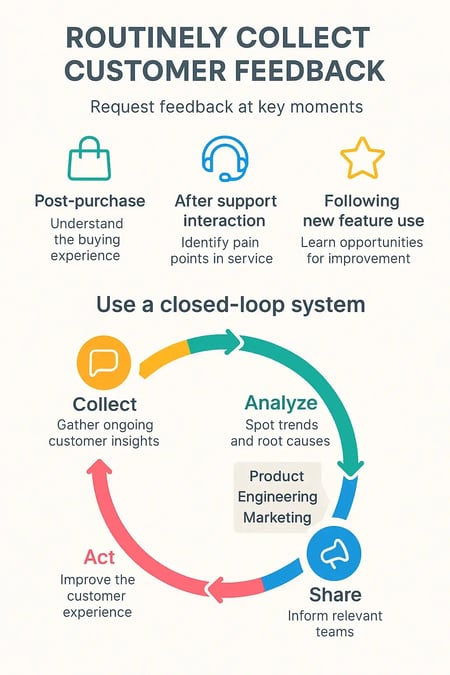
8. Track your team's performance.
I mentioned earlier that your CX strategy is a living document, not a “set it and forget it” plan.
You need to constantly track your performance against the metrics you established in the first step. At Skybound, I conduct weekly meetings alongside monthly and quarterly business reviews with our BPO support partners, translating complex performance data into the operational improvements we need to keep an updated customer experience strategy.
This constant cycle of analysis and iteration is how you stay ahead of changing customer needs and prove the ROI of your efforts.
Pro tip: Treat performance metrics as early warning systems and innovation indicators, not just historical reports. By consistently translating these insights into operational tweaks and strategic updates, you not only validate your CX investments but also proactively shape future customer experiences.
How to Create a Customer Experience Strategy
To create an impactful customer experience strategy, you must first understand customer experience design. This is the process of designing a frictionless and intuitive journey for customers at every touchpoint, ensuring their expectations are met and their problems are easily solved.
Now, with the core elements in place, it’s time to put them into action. Here’s a step-by-step process for building your customer experience strategy.
1. Create empathy maps for each customer persona.
Every great plan starts with the customer. To truly understand their experience, I recommend empathy maps. “Empathy maps are a visualization that captures and communicates our understanding of a set of users," shared Kate Kaplan, Insights Architect for Nielsen Norman Group. “There's a traditional structure to empathy maps: four quadrants that capture what the user says, thinks, feels, and does."
By filling this out for each of your key customer personas, you move beyond simple demographics and start to understand their motivations and pain points on a deeper level. I’ve included a slightly more detailed version below.
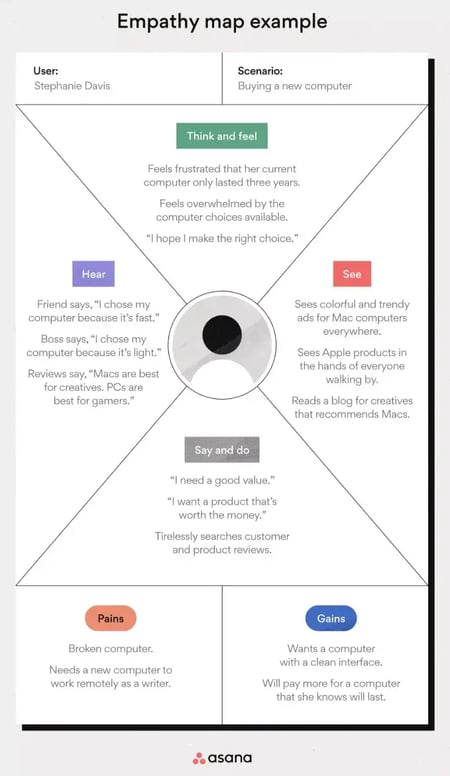
Best for: Cultivating a shared, profound understanding of your customer’s context and unspoken needs across product, design, and marketing teams, ensuring your solutions resonate deeply from the outset.
2. Review your customer journey map and identify user needs.
With your journey map in hand, your goal is to find the make-or-break moments. Where is the friction? Where do customers get frustrated and drop off? Conversely, where are those “aha!” moments where they truly grasp the value of your product? At Dapper Labs, we mapped the journey for new digital collectors and found that the initial digital wallet setup was a huge point of friction at the time. By zeroing in on and simplifying that single step, we dramatically improved the onboarding experience for our users.
Best for: Strategically prioritizing where to invest resources for maximal impact on customer satisfaction and business outcomes, by illuminating the most influential touchpoints in a customer’s real-world interaction with your product or service.
3. Collect early feedback to make your CX airtight.
Don’t wait until your customer experience strategy is “perfect” to get feedback. I’ve found it’s always better to involve beta users or a small group of trusted customers early in the process. Their initial reactions are invaluable.
Here are a few ways to collect feedback early on:
- Set up automated email behavior-based triggers for beta users to share feedback after every crucial touchpoint.
- Create focus groups to get qualitative, in-depth feedback on the most critical elements of your CX flow.
- Use heat maps to monitor in-app user behavior and find blockers, “aha!” moments, and other insights.
- Add micro surveys within the product to collect quantitative or subjective feedback about different aspects.
The bottom line? It’s better to delay a launch to improve your customer experience than to release a flawed one that causes frustration.
Best for: Fixing problems before they start. It helps you find and fix issues with new products or features early on, saving you time and money by making sure customers love the experience from day one.
4. Design workflows to quickly iterate on the experience.
Customer needs change, and your customer experience strategy must be agile enough to change with them. This requires creating smooth, cross-functional workflows. When feedback comes in, who is responsible for acting on it? How does a support insight get to the product team? At SmartRecruiters, we established a clear VoC feedback loop with Product that involved translating customer insights directly into actionable roadmap tickets. Formalizing this process is critical for quick iteration.
I think another critical step here is creating a culture of CX excellence. Train your employees to stay on top of customer expectations, present ideas for improvement, and drive innovation in product development. Enable them to support your customers.
Pro tip: Check out these AI tools for customer service to see if any can fit into your tech stack.
5. Track the effectiveness of your CX efforts.
Building the customer experience strategy is half the battle. Proving it works is the other half. You have to connect your CX efforts back to business outcomes.
“A lot of customer experience programs actually started with a measurement program or a feedback program, but they weren’t connected to that bigger strategy,” shares Walters. “This isn’t just setting up a customer feedback program or a day in the life of the customer. All of that is great, but it has to be tied back to the strategy."
Pro tip: To unlock deeper customer insights, encourage your Customer Success Managers to collaborate closely with marketing and product teams. Analyzing user behavior, both in and out of the product, creates a holistic view that identifies opportunities for growth and improvement across the entire customer journey. Tools like HubSpot's Customer Journey Analytics platform can be invaluable for gaining these comprehensive insights.
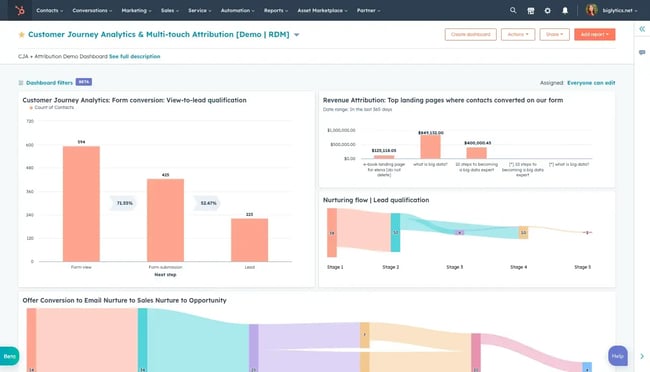
This tool gives you granular, real-time visibility into the entire customer journey, showing you exactly which campaigns and touchpoints drive revenue. Use this data to make smarter decisions, whether it’s for timing different aspects of your CX or for identifying your most crucial touchpoints.
Now, let’s build on that. I’ll walk you through the core best practices you need to define a comprehensive and cohesive customer experience strategy for your business.
Customer Experience Strategy Best Practices
- Reach your target audience.
- Offer convenient customer service.
- Be consistent in your customer service activities.
- Refine products and services based on customer feedback.
- Provide convenience when purchasing products.
- Create in-person & digital personalization.
- Focus on simplicity & ease of use.
- Review the flexibility of your communication channels.
- Use automation and AI.
- Be proactive.
- Engage in social listening.
- Invest in team training and culture.
1. Reach your target audience.
Don’t wait for customers to find you, engage them where they already are. If you’re not active on their preferred channels, you’re missing the critical moments when they’re most ready to listen or need help. At Skybound, we provide support across our Shopify store, Kickstarter campaigns, and various Discord channels for the community, ensuring we’re accessible wherever our fans engage.
Your first move is to identify the channels your customers actually use. Once you know where they are, study the environment. Ask yourself: How do people talk here? How can I join the conversation in a way that feels organic, not disruptive?
Being this reachable is a powerful competitive advantage. When you consistently deliver reliable service on their turf and in their language, you build loyalty that others can’t match.
2. Offer convenient customer service.
Convenience is king. In today’s always-on world, customers expect 24/7 access to support. This doesn’t mean you need a massive team working around the click. It means leveraging tools like a robust knowledge base or a chatbot to provide instant answers to common questions, no matter the time of day. The goal is to make getting help as frictionless as possible.
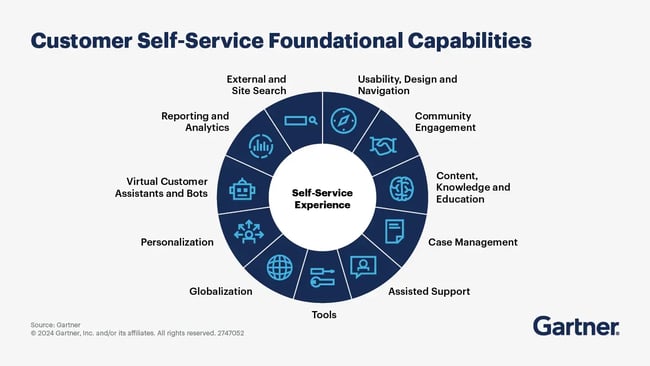
3. Be consistent in your customer service activities.
Trust isn’t a slogan; it’s the outcome of consistency. Every customer interaction is a chance to either build that trust or shatter it. This requires every team, from sales to support, to follow the same playbook.
Audit your policies and processes. Are they up-to-date and reasonable? More importantly, are they applied consistently to every customer and every scenario? Stress-test your systems for common friction points like returns or exchanges. One bad experience can erase months of goodwill and kill a future sale.
4. Refine products and services based on customer feedback.
No matter how much work goes into perfecting the back end of your customer experience, it's important to remember that customers ultimately bought a product or service from your company. As a result, they expect it to be valuable and high-quality.
Refine your products and services based on customer feedback provided by an NPS survey, focus groups, or one-on-one customer calls. Solving the root of the issue with a product or service you already sell can create a better overall customer experience. It doesn‘t matter how outstanding your customer experience strategy is if your product isn’t functional.
%20for%20customer%20experience.webp?width=650&height=434&name=net%20promoter%20score%20(nps)%20for%20customer%20experience.webp)
5. Provide convenience when purchasing products.
Don’t make it difficult for people to give you their money. From your Shopify store to your SaaS pricing page, the purchasing process should be simple, transparent, and frictionless. This means clearer pricing, easy checkout, and multiple payment options. Every click you can remove from the checkout process is a win for the customer experience. In my work overseeing e-commerce, we obsess over this. My team and I analyze the checkout flow constantly, looking for any point of friction we can eliminate to make the path to purchase as smooth as possible.

6. Create in-person & digital personalization.
Customers know you have their data and expect you to use it to create a more relevant experience. According to McKinsey research, 71% of consumers expect companies to deliver personalized interactions, and 76% get frustrated when this doesn’t happen. At Trendy Butler, we used an AI-powered survey to understand a member’s specific style preferences, which allowed us to personalize the clothing they received in their subscription box. That level of personalization can be a differentiator.
7. Focus on simplicity & ease of use.
Never underestimate the power of simplicity. Whether it’s your website navigation, your product’s UI, or your support process, making things easy for the customer reduces their effort and increases their satisfaction. A low Customer Effort Score (CES) is a strong indicator of a healthy customer experience.
I recommend conducting a “friction audit.” Walk through your most critical customer journeys from the perspective of a brand-new user. Try to purchase a product, find your return policy, or get help with a common issue. Your mission is to find and question every step. Is every click necessary? Is every instruction crystal-clear? Your goal is to ruthlessly eliminate any obstacle that stands between your customer and their goal.
8. Review the flexibility of your communication channels.
An omni-channel support strategy means providing a seamless and integrated experience across all your communication channels. The context of a customer’s conversation should follow them from a chatbot to a live agent to an email follow-up. They should never have to repeat their issue. This requires a tightly integrated tech stack where your CRM, help desk, and communication tools all speak the same language.
If you‘re looking to streamline channel flexibility as a key part of your customer experience strategy, I recommend getting your team together to talk about what you want the customer experience to look, feel, and sound like across all channels. Like I mentioned earlier, don’t forget to place yourself where the customer is. From there, you’ll have the common ground you need to begin employing a more fluid, contextual experience.
9. Use automation and AI.
No business wants its service to feel robotic. But the truth is, as your business grows, it will be more difficult to provide the same personalized service that you did when you were only managing a handful of customers. That‘s not to say keeping your standards up is impossible, just that you’ll need a little help. Luckily, artificial intelligence can help.
It’s no longer a futuristic concept. I’m a big fan and believe these new generative large language models give service departments the opportunity to scale in an efficient and personalized manner. The 2024 HubSpot State of Service Report found that 75% of service leaders already use AI, and 83% say it makes it easier to respond to service requests.
I like to think of it as giving my team superpowers, accelerating their existing skillsets to provide even better service. For example, a chatbot can act as your 24/7 frontline agent, instantly handling common inquiries or guiding users to a knowledge base, ensuring no customer is ever left waiting.
Meanwhile, AI tools like those in Service Hub work in the background, summarizing calls with suggested action items and helping your human agents focus on solving the complex problems that require their expertise.
Pro tip: HubSpot has a tool called Breeze, which is a free AI-powered assistant to help supercharge your work. Check it out.
10. Be proactive.
I personally think one of the ultimate goals of a mature customer experience strategy is to shift your support model from reactive to proactive. Instead of waiting for customers to report problems, you use data to anticipate their needs. This requires creating a system that identifies and solves issues before the customer even has to ask for help.
Whenever I work on new video game releases, the developer team and I always collaborate to identify known issues before release day, and take the time to seriously think through potential issues. It allows us to have communication and FAQs ready, instead of waiting for the wave of support tickets. This approach shows customers you understand their journey and are invested in their success, which is one of the most powerful ways to build lasting loyalty.
11. Engage in social listening.
What better way to learn the customer experience than from their own social media?
Social listening is the monitoring of your brand's social presence to better understand sentiment, identify emerging issues, and engage with your community. It provides a raw, unfiltered feedback that you won’t always get through official channels.
I’ve found that if you’re attentive enough, you can discover the pain points in the customer journey and other insights that can positively impact the customer experience. Here are a few tools to track messages across social media for your business.
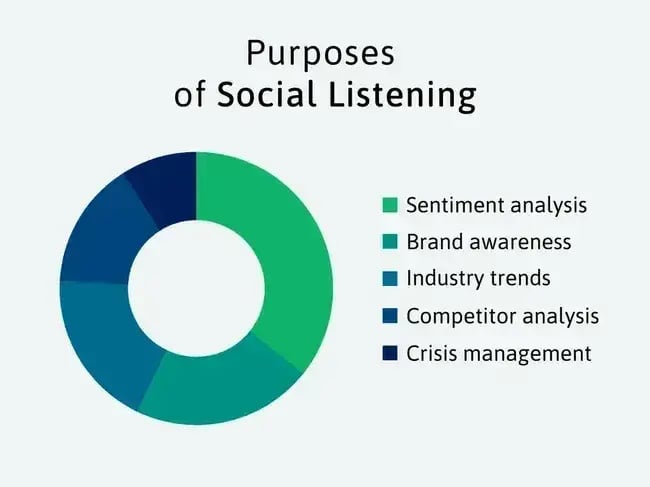
12. Invest in team training and culture.
I strongly believe that the quality of your customer experience will never exceed the quality of your employee experience. That’s why employee training cannot be a one-time onboarding task. It must be a continuous part of your culture.
This starts by embedding your CX mission into the entire employee journey. Go beyond standard product training and prepare your team for real-world, face-to-face interactions that define your brand.
As Jeannie Walters says, "We want to embed customer experience throughout the employee journey, blending our CX mission and messaging into the entire journey. If we can connect a great customer experience with an empowered and engaging employee experience, then everybody wins.”
The most effective way to do this is through routine role-play workshops. Create simulations that test how your team handles different situations, from a simple customer greeting to solving a unique problem or guiding a customer through complex options. These sessions create a space for direct, peer-to-peer feedback on communication, attitude, and presentation, ensuring your team is fully aligned and ready to exceed expectations.
How to Measure Your Customer Experience Strategy
Building an excellent CX flow isn't a game of guesswork. You have to strategically measure the impact of your customer experience strategy and make enhancements based on data-backed evidence.
Here are the essential metrics to track:
- Customer satisfaction score (CSAT): Track this to gauge users’ satisfaction with specific interactions.
- Net promoter score (NPS): To measure overall customer loyalty.
- Customer effort score (CES): To assess how easy it is for users to get help or use your product.
- Customer lifetime value (CLV): To calculate the total value you gain from a customer.
- Retention and churn rates: To measure how many customers you keep versus how many you lose.
- Support tickets: To assess the volume and types of issues users commonly struggle with.
Tracking these core CX metrics gives you a pulse of your customers and flags any gaps you need to address in the experience.
Quick Tips for Optimizing Your Customer Experience Strategy
As user needs evolve, you’ll have to continuously optimize your CX strategy. Here are a few quick tips that have worked for me through my career:
- Establish always-on feedback loops to regularly collect input from users.
- Connect with your power users to understand how your product is helping them achieve their goals and identify areas for improvement.
- Pay close attention to user session recordings or heatmaps to find real-time insights on where users get stuck or feel confused.
I’ve learned that the best optimization ideas rarely come from a “boardroom” meeting. They come from listening closely to your customers and watching where they struggle.
Customer experience strategy is a long-term play.
Building a world-class customer experience is a marathon, not a sprint. My advice is to work on defining and streamlining your customer experience design, but do so under the notion that things will need to evolve as your business and customer base grow. I’ve discovered that as I learn what it means to communicate with customers on their terms and collect data along the way, I find it easier to make informed decisions about my overall customer experience strategy. I hope you discover this, too!
Editor's note: This post was originally published in August 2020 and has been updated for comprehensiveness.
Customer Experience


.webp)

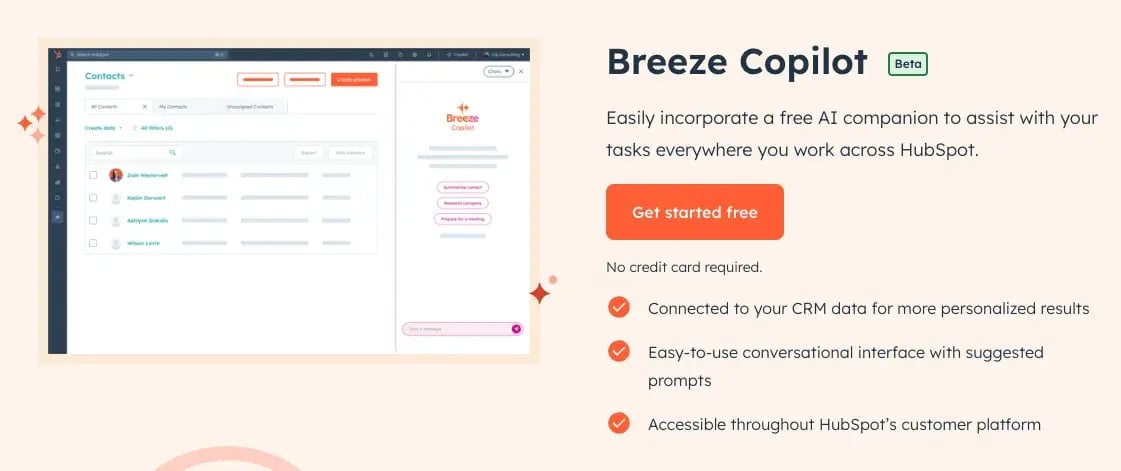


![Is The Customer Always Right? [What It Means + Why It Matters]](https://53.fs1.hubspotusercontent-na1.net/hubfs/53/customer-is-always-right-origin-1-20250202-6448090.webp)






![14 Best Practices for B2B Customer Experience [New Data]](https://53.fs1.hubspotusercontent-na1.net/hubfs/53/b2b-customer-experience_2.webp)